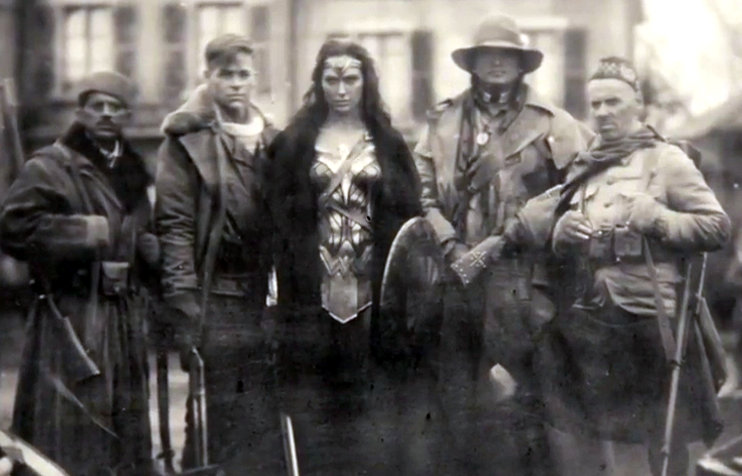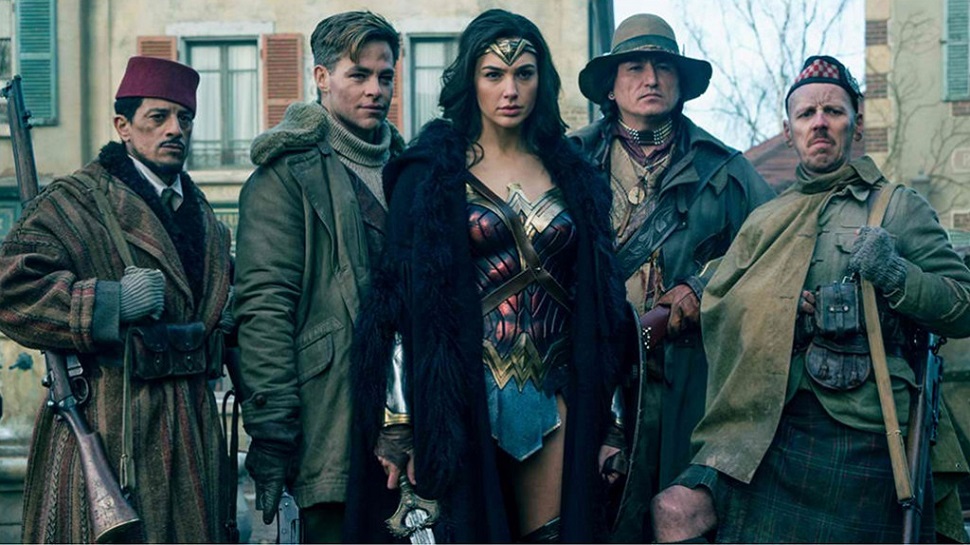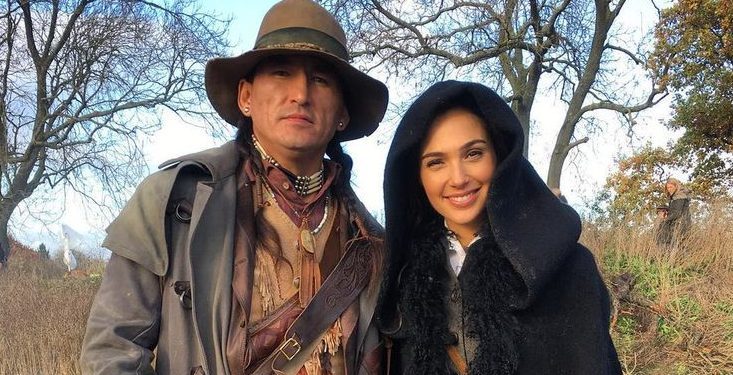Patty Jenkins’ Wonder Woman has been a revelation to many who love film. Not only did the film open up the box office to finally accepting a female superhero, but it also paved the way for one of DC’s longest-standing, but often misrepresented character, Apache Chief. In the film, the character is treated a lot more seriously and realistically, only going by “The Chief” to mere mortals, but is actually Napi, a Blackfoot demi-god hoping to protect his people and fight against evil.
The Chief got much of is backstory from actor Eugene Brave Rock, who integrated parts of his own background into the character to make an even richer experience for himself as an actor, for the film, and for the viewer, especially those who might not have ever seen a non-stereotypical portrayal of Native Americans. The role was even more special for Native American viewers, who rarely see themselves portrayed in full in the media.
I was able to catch up with three Wonder Woman fans who are also African-American and Native-American. From their points of view, the DCEU—and movies in general—can only get better with the inclusion of more Native American characters like the Chief.
Cherry Davis, pop culture and lifestyle blogger and Afterbuzz TV guest host, said she is 1/16 Blackfoot and that the Chief is a rare character in a landscape lacking in complex Native roles.
“…[It’s] likely the second time I’ve seen a Native/Indigenous character played by someone of that ethnic background. So big hurrah for that casting choice!” she said. “What stood out was that he didn’t speak in the ‘Entertainment Native Dialect’ and that he wasn’t subservient to the white characters.”
“He was definitely the icing on an already delicious cake of a film. As soon as he appeared on the screen, I all but screamed Super Friends Reunion!” said Dennis R. Upkins, speculative fiction author and activist as well as part Cherokee. “He definitely had a mystique about and while we know little about this mysterious character, he was established enough that he could take the lead in his own narrative in the DCEU.”
Cherese Capadona, who is part Mississippi Choctaw, said what struck her the most about the Chief was his unapologetic approach to talking about “the Native American relationship with White Americans after colonization.” She said the Chief’s statement that men like Steve Trevor killed his people “was accurate.”
“It didn’t say they couldn’t have a good working relationship or couldn’t be friends, but that’s never been addressed in any television show, anything I’ve ever remembered seeing growing up like The Lone Ranger, which has my least favorite representation of a Native American character ever.”

Due to her Blackfoot heritage, the Chief hits even closer to home for Davis, who also minored in Native American Studies.
“This is dear to me,” she said. “…[I] am always excited to see diverse characters [and] characterizations. I applaud Patty Jenkins for allowing Eugene Brave Rock to truly make the character his own, imbuing the Chief with a backstory nod to his people. Also, a huge nod to Eugene for taking this opportunity as a platform for Native American Blackfoot mythology. I’m hoping that people will be excited enough to read more and that DC Comics will have a ‘hmm’ moment. Expand on his mythology, cast him in some of the DC TV series to gather a fanbase and eventually comic book movie/series/cartoon around an entire mythology that people have little awareness of.”
She said seeing someone like the Chief on the big screen would be “incredible” to Native audience members who usually don’t see themselves represented. She said an audience member might feel “vindicated and excited to see not only someone who looks like them but is one of them and [is] a character treated with dignity in such a huge film.”
“I’m hoping that this will lead to seeing Chief in other films since as a demigod he’ll live for a long time,” she said.
“I can definitely speak for myself and say that…I felt relieved first of all that he wasn’t just coming in because his name was the Chief,” said Capadona. “You can almost imagine the eyerolling—what’s this character going to be like? But he isn’t what you would expect. Usually when there’s a character called the chief in a movie, there’s a stereotypical headdress, speaking broken English. There are just so many things that are stereotypical and none of that was there. Once I got over the relief portion, I was pretty happy.”
Capadona also hopes the Chief will make more people interested in learning more about the mythology of the nation’s first inhabitants.
“We spend so much time teaching kids Greek mythology and Roman mythology. Since we’ve come out with the Thor movies and The Avengers, there’s been an interest in Norse mythology. [There’s an interest in] Egyptian mythology. There’s never been characters from Native American mythology and every nation has their own creation stories and tales that follow in the realm of mythology,” she said. “I would hope that the chief being a demi-god would spark as much interest in those mythologies and kids don’t get exposed to any of things that are from this land, from this country. Whether you’re Native American or African American, we have our own stories [and] folklore. That was just really exciting for me.”
Upkins said he felt the inclusion of the Chief shows just how inclusive the movie-going experience can be.
“Being part Cherokee, I’m always excited to see this aspect of my culture reflected in the media, particularly in speculative fiction,” he said. “The film’s openness is a reflection of how inclusive Wonder Woman and for that matter the DCEU is. Diana herself is queer/bisexual protagonist which she all but states in the film when she references the fact that men are good for procreating but sexual gratification is best with other women. This is also the film that got to see queer black super heroines get some shine battling the German invaders. This inclusiveness has already paid off in dividends of $700 million worldwide.”
Brave Rock’s portrayal is one of a small number of Indigenous characters or characters played by Indigenous actors to take part in the DCEU. In Suicide Squad, Adam Beach, a member of the Saulteaux First Nations, portrays anti-hero Slipknot, and in Aquaman and Justice League, Jason Momoa, who is of Native Hawaiian, Irish, German, and Native American descent, is portraying Aquaman himself.

Upkins said that the inclusion of the Chief and the addition of Brave Rock’s characterizations “debunks all excuses” for other films when it comes to a lack of proper representation.
“It shows that you can have Native characters in supporting and leading roles and still have a successful film,” he said. “Any claims to the contrary are dead on arrival.”
“You don’t often see Native or people of color during that time period [of Wonder Woman] so it’s sad to say but it’s kind of groundbreaking which is positive but also sad that this type of portrayal is still rare in the 21st century,” he said.
Davis also hopes the film will lead to more casting that accurately portrays the character’s background instead of erasing it.
“…[A]sk [actors] how they can bring their life experience into the role,” she said. “People not only want to see themselves reflected but people both other ethnic/religious background are receptive and interested in seeing new talented faces.”
“I would hope that it would open up another door to not necessarily cast …It’s frustrating, and I know that several people have said this, not just Native Americans…[people] are getting frustrated by roles that are created and they want that character to have a specific look, they have to be Caucasian, this, that or the other,” said Capadona. “The most recent example of someone who is breaking down those barriers is Ava DuVernay’s casting in A Wrinkle in Time. When I was growing up and I read that book, I thought in my mind—because that’s the way everyone portrayed the character to me—that Meg Wallace was a character that should have been white, and here in the film she’s going to be biracial. It’s wonderful the way she’s done that. She’s cast a rainbow of other characters.”
With it being 2017, said Capadona, proper representation and staying away from the “Noble Native” stereotype shouldn’t be an issue. But she hopes accuracy in representation comes “sooner rather than later.”
“I’m just hoping other people will take the hint and do what Patty has done and create more roles and more opportunities for the actors and actresses to enrich these stories they want to tell,” she said.
The roles Capadona, Davis, and Upkins want to see the most involve Native characters living outside of the stereotype.
“I want to see them in the same type of roles that white counterparts have, from playing a bad guy to a hero, to love interest to just being a nuanced human with flaws in all genres,” said Davis.
Upkins said he’d love to see “[q]ueer male leads in speculative fiction.” Capadona said she’d love to have Native characters in all walks of life.
“I would love to see, because I love science-fiction, maybe some science-fiction elements added to a Native American story. I’d love to see a Native American actor or actress play a scientist, somebody who’s beyond the geologist or archeologist—somebody that’s actually doing astrophysics and going into space. We’ve had Native American astronauts; it’d be wonderful to see those kind of characters,” she said. “It’d be wonderful to see a Native American love story on the screen or even interracial, but not something that’s this tragic thing where it’s “My father doesn’t approve of you, I’m going to shame my family because I’m marrying you.” Just something beyond those typical things. Something off the reservation—there are middle class Native Americans in this country. Everybody isn’t on the reservation and dealing with reservation politics and poverty. Something that’s uplifting and showing people as multifaceted.”
“We’re starting to see more facets of Native American culture and I think the role of the chief is starting to turn the gemstone to see those different facets, but we still have a lot of turning to do and I’m really hoping this is the start.”♦
Wonder Woman comes to DVD and Blu-ray Sept. 19.
Loved this article? Follow JUST ADD COLOR at @COLORwebmag and on Facebook!
